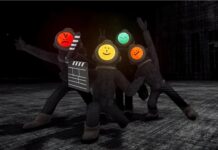When Tokyo RPG Factory released its first game, I am Setsuna, the mission statement was making games reminiscent of Square’s golden age of RPGs. It was a lofty goal from the get-go, but the more of their titles I play, the clearer it becomes that you need more than Active Time Battles to inspire nostalgia – if anything I’m now more convinced than ever that they really don’t make ’em like they used to.
Tokyo RPG Factory’s latest, Oninaki, takes place in a world ruled by the belief in death and reincarnation. I’m always interested in JRPGs that handle death, since some of them – chiefly Final Fantasy 10 and Tales of Berseria – offer interesting angles on the topic, studied through the lens of Buddhism and Shintoism. Oninaki, on the other hand, has nothing interesting to say.
It does in fact have so little to say that after 30 hours with it I’m not sure what the plot was, or if there was one as opposed to a sequence of various tasks. You take control of Kagachi, a white-haired boy who after the death of his parents joins the Watchers, a group of people with the ability to walk between the world of the dead and the living. If someone dies with regrets, they stay behind as a ghost instead of being reincarnated, and so the Watchers take on any problem that may keep someone from peacefully passing on. This isn’t quite at the level of “oh no, I’ve left the oven on”, but too often, especially in case of ghosts you randomly come across, all you have to do is visit a specific place on the map again so that they can see it one last time.

Walking between worlds isn’t Kagachi’s only talent – he can also bond with daemons, ghosts who can’t pass because they’ve lost their memories for some reason. Monsters in Oninaki meanwhile, are called Fallen – they happen when ghosts soak themselves full of hatred and become monsters, but don’t ask why, unlike the other two, you can also find them in the real world.
Here, random combat is a thing of the past, and all monster freely roam the various dungeon maps. Daemons meanwhile, also act as your weapon and your special attack. You can have a roster of up to four daemons equipped, which you call to in Persona-like fashion while still keeping control of Kagachi. Equipping the daemon Dia for example, turns Kagachi’s basic attack into a long-range attack with pistols, special attacks consist of firing huge blasts or deadly volleys together with his daemon. Equipping Wil gives you a huge two-hander and so forth.
Monsters drop weapons for each daemon. There’s also a system for socketing upgrades into your weapons, but since Oninaki doesn’t have a system for you to track the resulting stat increases, these are more nice to have than anything you could actually plan a strategy by. Of course there is also a daemon skill tree which lets you unlock buffs, new special attacks and daemon memories, which you can watch in mostly static cutscenes of the daemons as they tell you their story in voice-over.

It’s fun to switch between daemons and try out their different weapons and attacks, but basic combat is a bit of a slog. There’s little more than a handful of enemy types, and Oninaki shoves them at you in such huge numbers that you can move across the map by the forward thrust of your attack alone if you want to, and you’re going to spend a lot of time simply spamming the attack button.
The world itself is very bland, made up of generic dungeons in the same shade of brown. Sometimes you need to switch between the ghost realm and the real world with the press of a button. The otherworld is the same map you’re on just in blue, but you need to go there in order to make ghosts visible and sometimes to bypass an obstacle. It’s a mostly superfluous mechanic.
Boss battles, though, are a joy. These things are relentless, and you have to keep moving at all times to evade attacks and then find that small window of time in which you can successfully hit them with a special attack. Granted, it’s no Dark Souls, but since every special attack leaves you immobile while at the same time you have to get close enough to your enemy to hit, finding the right moment to do all that is a tense affair. You’ll likely end up taking a hit in exchange for getting one in. Oninaki expects you to, as multiple bosses will do nothing but chase you in circles until you’re close enough to hit.
I’m generally bewildered by how much work went into the daemons as opposed to just about everything else. It feels very much like someone came up them then tried to build a game around it without really investing in any other aspect. The fact that the daemons don’t speak yet are your only form of a battle party immediately puts a huge cork in storytelling, because you can’t have much of a story if there is literally no one to interact with.

Kagachi’s only personality trait meanwhile, is that he’s constantly moody, not in a charming Tales of Vesperia way or a fondly exasperating Final Fantasy 8 way. He’s just fundamentally dislikeable. No character you meet is ever around for long, and they just never have actual conversations. They make battle plans, as in “you go left, I go right” while I sit in front of my TV, desperately wondering who these people are and why I should care. Whatever the role of a Watcher is also highly malleable, as at some points in the game it’s to protect the realm, then it’s to aid the dead, then it’s to protect the will of the people, which tells you how much work went into cohesive world-building.
Sure, the overall plot, if you care to remember it, is nothing we don’t get from JRPGs every other Sunday. An evil must be fought. But Oninaki never wants to look much deeper than that; the writing is truly bad – not goofy or overwrought in the way JRPGs tend to be, just plain bad. The localisation sometimes gives out completely in the face of very Japanese expressions, and battle shouts, of which there are many, haven’t even been translated – not even the useful ones that tell you that you’re about to die or that there’s a treasure chest nearby.
One good idea isn’t enough to make a good game – not unless you put a bit of love in the building blocks that surround it. Many JRPGs have that heart, the same one that mellows you even to their most ridiculous qualities. Oninaki, on the other hand, comes across as loveless.































